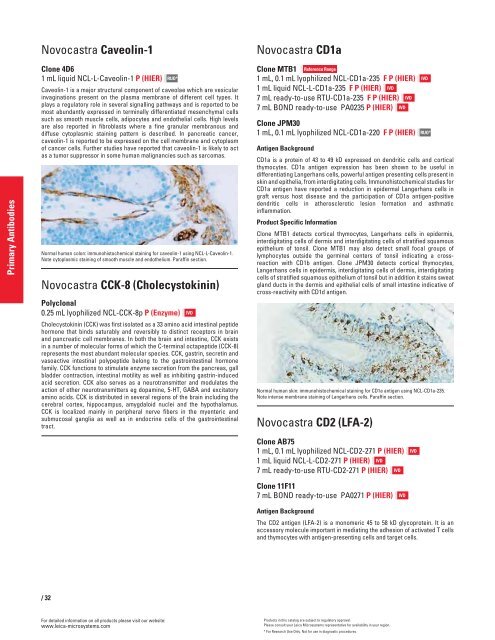QF0159 Marketing Release Record
QF0159 Marketing Release Record
QF0159 Marketing Release Record
Create successful ePaper yourself
Turn your PDF publications into a flip-book with our unique Google optimized e-Paper software.
Primary Antibodies<br />
Novocastra Caveolin-1<br />
Clone 4D6<br />
1 mL liquid NCL-L-Caveolin-1 P (HIER)<br />
Caveolin-1 is a major structural component of caveolae which are vesicular<br />
invaginations present on the plasma membrane of different cell types. It<br />
plays a regulatory role in several signalling pathways and is reported to be<br />
most abundantly expressed in terminally differentiated mesenchymal cells<br />
such as smooth muscle cells, adipocytes and endothelial cells. High levels<br />
are also reported in fibroblasts where a fine granular membranous and<br />
diffuse cytoplasmic staining pattern is described. In pancreatic cancer,<br />
caveolin-1 is reported to be expressed on the cell membrane and cytoplasm<br />
of cancer cells. Further studies have reported that caveolin-1 is likely to act<br />
as a tumor suppressor in some human malignancies such as sarcomas.<br />
Normal human colon: immunohistochemical staining for caveolin-1 using NCL-L-Caveolin-1.<br />
Note cytoplasmic staining of smooth muscle and endothelium. Paraffin section.<br />
Novocastra CCK-8 (Cholecystokinin)<br />
Polyclonal<br />
0.25 mL lyophilized NCL-CCK-8p P (Enzyme)<br />
Cholecystokinin (CCK) was first isolated as a 33 amino acid intestinal peptide<br />
hormone that binds saturably and reversibly to distinct receptors in brain<br />
and pancreatic cell membranes. In both the brain and intestine, CCK exists<br />
in a number of molecular forms of which the C-terminal octapeptide (CCK-8)<br />
represents the most abundant molecular species. CCK, gastrin, secretin and<br />
vasoactive intestinal polypeptide belong to the gastrointestinal hormone<br />
family. CCK functions to stimulate enzyme secretion from the pancreas, gall<br />
bladder contraction, intestinal motility as well as inhibiting gastrin-induced<br />
acid secretion. CCK also serves as a neurotransmitter and modulates the<br />
action of other neurotransmitters eg dopamine, 5-HT, GABA and excitatory<br />
amino acids. CCK is distributed in several regions of the brain including the<br />
cerebral cortex, hippocampus, amygdaloid nuclei and the hypothalamus.<br />
CCK is localized mainly in peripheral nerve fibers in the myenteric and<br />
submucosal ganglia as well as in endocrine cells of the gastrointestinal<br />
tract.<br />
/32<br />
For detailed information on all products please visit our website:<br />
www.leica-microsystems.com<br />
RUO*<br />
IVD<br />
Novocastra CD1a<br />
Clone MTB1 Reference Range<br />
1 mL, 0.1 mL lyophilized NCL-CD1a-235 F P (HIER)<br />
1 mL liquid NCL-L-CD1a-235 F P (HIER) IVD<br />
7 mL ready-to-use RTU-CD1a-235 F P (HIER) IVD<br />
7 mL BOND ready-to-use PA0235 P (HIER) IVD<br />
Clone JPM30<br />
1 mL, 0.1 mL lyophilized NCL-CD1a-220 F P (HIER)<br />
Antigen Background<br />
CD1a is a protein of 43 to 49 kD expressed on dendritic cells and cortical<br />
thymocytes. CD1a antigen expression has been shown to be useful in<br />
differentiating Langerhans cells, powerful antigen presenting cells present in<br />
skin and epithelia, from interdigitating cells. Immunohistochemical studies for<br />
CD1a antigen have reported a reduction in epidermal Langerhans cells in<br />
graft versus host disease and the participation of CD1a antigen-positive<br />
dendritic cells in atherosclerotic lesion formation and asthmatic<br />
inflammation.<br />
Product Specific Information<br />
Clone MTB1 detects cortical thymocytes, Langerhans cells in epidermis,<br />
interdigitating cells of dermis and interdigitating cells of stratified squamous<br />
epithelium of tonsil. Clone MTB1 may also detect small focal groups of<br />
lymphocytes outside the germinal centers of tonsil indicating a crossreaction<br />
with CD1b antigen. Clone JPM30 detects cortical thymocytes,<br />
Langerhans cells in epidermis, interdigitating cells of dermis, interdigitating<br />
cells of stratified squamous epithelium of tonsil but in addition it stains sweat<br />
gland ducts in the dermis and epithelial cells of small intestine indicative of<br />
cross-reactivity with CD1d antigen.<br />
Normal human skin: immunohistochemical staining for CD1a antigen using NCL-CD1a-235.<br />
Note intense membrane staining of Langerhans cells. Paraffin section.<br />
Novocastra CD2 (LFA-2)<br />
Clone AB75<br />
1 mL, 0.1 mL lyophilized NCL-CD2-271 P (HIER)<br />
1 mL liquid NCL-L-CD2-271 P (HIER) IVD<br />
7 mL ready-to-use RTU-CD2-271 P (HIER) IVD<br />
Clone 11F11<br />
7 mL BOND ready-to-use PA0271 P (HIER)<br />
Antigen Background<br />
The CD2 antigen (LFA-2) is a monomeric 45 to 58 kD glycoprotein. It is an<br />
accessory molecule important in mediating the adhesion of activated T cells<br />
and thymocytes with antigen-presenting cells and target cells.<br />
Products in this catalog are subject to regulatory approval.<br />
Please consult your Leica Microsystems representative for availability in your region.<br />
* For Research Use Only. Not for use in diagnostic procedures.<br />
IVD<br />
IVD<br />
IVD<br />
RUO*
















